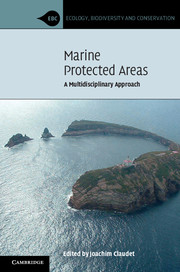Book contents
- Frontmatter
- Contents
- Contributors
- Introduction
- Part I Threats to marine ecosystems and resources
- Part II Effects of marine protected areas
- 2 ECOLOGY – Ecological effects of marine protected areas: conservation, restoration, and functioning
- 3 FISHERIES – Effects of marine protected areas on local fisheries: evidence from empirical studies
- 4 BIOECONOMY – Economically optimal spatial and inter-temporal fishing patterns in a metapopulation
- 5 SOCIO-ECONOMY – Social dynamics of scaling-up marine protected area declarations and management
- Part III Assessment of the effectiveness of marine protected areas
- Part IV Scale-up of marine protected area systems
- Index
- References
3 - FISHERIES – Effects of marine protected areas on local fisheries: evidence from empirical studies
from Part II - Effects of marine protected areas
Published online by Cambridge University Press: 05 August 2012
- Frontmatter
- Contents
- Contributors
- Introduction
- Part I Threats to marine ecosystems and resources
- Part II Effects of marine protected areas
- 2 ECOLOGY – Ecological effects of marine protected areas: conservation, restoration, and functioning
- 3 FISHERIES – Effects of marine protected areas on local fisheries: evidence from empirical studies
- 4 BIOECONOMY – Economically optimal spatial and inter-temporal fishing patterns in a metapopulation
- 5 SOCIO-ECONOMY – Social dynamics of scaling-up marine protected area declarations and management
- Part III Assessment of the effectiveness of marine protected areas
- Part IV Scale-up of marine protected area systems
- Index
- References
Summary
Marine protected areas for fisheries
Marine fisheries throughout the world are in serious decline due to overharvesting (National Research Council, 2001), and management for sustainable fisheries requires effective tactics for limiting exploitation rates. Limitations based on annual stock assessments and total allowable catches calculated from these assessments can be dangerous, and marine protected areas (MPAs) are one tool to limit exploitation rates directly even when total stock size is highly uncertain (Walters, 2000). Contrary to other management strategies usually involving a suite of regulations (e.g., gear and vessel restrictions, minimum sizes, catch and effort limits, prohibited species), MPAs are easier to enforce and can be more easily understood by the public and the fishing industry (Guidetti and Claudet, 2010). Within a fisheries management context the main expected outcome of MPAs is yield enhancement, but MPAs also hold the potential to reduce impacts of fishing on marine ecosystems and to establish undisturbed, reference locations for scientific studies (Fogarty et al., 2000). However, creating an MPA reduces the area that can be fished, thus potentially reducing yield. The question is therefore whether the yield in the area remaining open will increase enough to offset losses from the closed area (Hilborn et al., 2004; Jones, 2008; see also Chapter 4), and whether the displaced fishing effort reduces the sustainability of remaining fishing grounds (Hilborn et al., 2004). These concerns would be lessened if total catch was reduced by a percentage equivalent to the habitat protected within MPAs (Parrish, 1999).
During recent years there has been a proliferation of studies assessing the efficacy of MPAs in rebuilding exploited populations within their boundaries. Most of them document increases in target species abundance, biomass, individual size, and egg production following the reduction or cessation of fishing (see reviews by Fogarty et al., 2000; Sánchez-Lizaso et al., 2000; National Research Council, 2001; Russ, 2002; Claudet et al., 2008; Molloy et al., 2009; Claudet et al., 2010; see also Chapter 2). However, while there is general agreement about the potential of MPAs as conservation tools, attention to their effects on fisheries has grown particularly controversial (Hilborn et al., 2004). Controversy is nurtured by the above-mentioned concerns of loss of fishing grounds and impacts of effort displacement, although the scarcity of empirical studies rigorously evaluating such effects is also slowing down progress in the research and implementation of MPAs with fishery management objectives (Russ, 2002; Willis et al., 2003a; Hilborn, 2006; see also Chapter 7).
- Type
- Chapter
- Information
- Marine Protected AreasA Multidisciplinary Approach, pp. 72 - 98Publisher: Cambridge University PressPrint publication year: 2011
References
- 14
- Cited by



